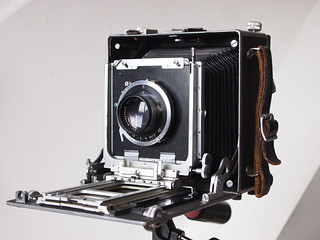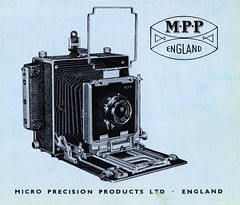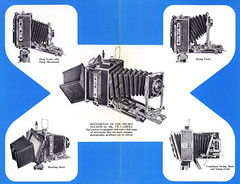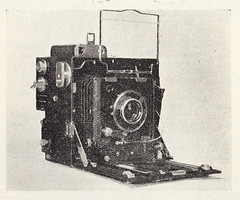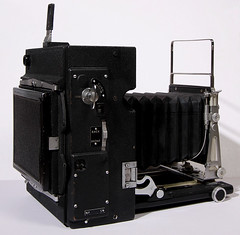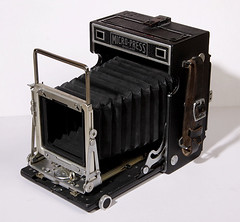Difference between revisions of "MPP"
(→Sources) |
Hanskerensky (talk | contribs) m (→External links: Redirected Link URL to new site) |
||
| (19 intermediate revisions by 7 users not shown) | |||
| Line 1: | Line 1: | ||
| − | + | <div class="plainlinks" style="float:right; margin: 0 0 10px 10px; text-align:center; border:1px black dotted; padding:2px">[http://www.flickr.com/photos/nicholasmiddleton/5492461554/in/pool-camerawiki http://farm6.static.flickr.com/5014/5492461554_526df785e1_n.jpg]<br /> | |
| − | + | MPP Micro Technical Mk VI,<br />introduced 1952<br /> | |
| − | + | <small>Image by {{Image author|Nicholas Middleton|nicholasmiddleton}}</small><br /> | |
| − | + | {{With permission}} | |
| − | + | </div> | |
| − | | | + | '''Micro Precision Products Ltd''' (M.P.P.) was a British optical company that between 1941 and 1982 produced cameras and related equipment. (From 1976, its name was '''MPP Photographic Products Ltd.'''<ref>Skinner, p.15.</ref>) |
| − | |||
| − | }}'''Micro Precision Products Ltd''' (M.P.P.) was a British optical company that between 1941 and 1982 produced cameras and related equipment. (From 1976, its name was '''MPP Photographic Products Ltd.''' | ||
| − | |||
| − | |||
| − | |||
| + | MPP was formed in 1941 to sell photographic equipment produced by Celestion Ltd., primarily a loudspeaker manufacturer. The early employees of MPP came from Celestion or the related McMurdo Instrument Company and Harrow Machine Company,<ref>Skinner, p.7.</ref> employees would move between Celestion and MPP work for some time.<ref>Skinner, p.11.</ref> MPP was based in London: in Kingston until 1976, Wandsworth thereafter.<ref>Skinner, pp. 7, 15.</ref> | ||
| + | The company stopped most of its operations in 1982 but continued to sell parts until it was finally dissolved in 1989.<ref>Skinner, pp. 16, 17.</ref> | ||
== Products == | == Products == | ||
| − | MPP's first major product was the '''Micro Technical Camera''', in 1948. This was far in advance of any other camera produced in Britain. Mark II followed in 1949; Mark III in 1951; [[M.P.P. Micro Technical Mark VI|Mark VI]], [[M.P.P. Micro Technical Mark VII|Mark VII]] and [[MPP Micro Technical Mark VIII|Mark VIII]] in 1952, 1956, and 1963. (Mark IV and Mark V were not sold.) These were versatile professional [[folding bed camera]]s, designed as sturdy compact [[view camera]]s, almost like [[press camera]]s but without sports finder. Some are still (2005) in professional use. | + | MPP's first major product was the '''Micro Technical Camera''', in 1948.<ref>Skinner, p. 19.</ref> This camera, for 4×5 in. sheet film, was far in advance of any other camera produced in Britain.<ref>Skinner, p.22.</ref> Mark II followed in 1949; Mark III in 1951; [[M.P.P. Micro Technical Mark VI|Mark VI]], [[M.P.P. Micro Technical Mark VII|Mark VII]] and [[MPP Micro Technical Mark VIII|Mark VIII]] in 1952, 1956, and 1963. (Mark IV and Mark V were not sold.) These were versatile professional [[folding bed camera]]s, designed as sturdy compact [[view camera]]s, almost like [[press camera]]s but without sports finder. Some are still (2005) in professional use. |
| − | |||
The MPP Mk VII. | The MPP Mk VII. | ||
| − | |||
| − | |||
| − | |||
| − | |||
| − | |||
| − | |||
| − | |||
| − | |||
| − | |||
| − | |||
| − | |||
| − | |||
| − | |||
| − | |||
| − | |||
| − | |||
| − | |||
| − | |||
| − | |||
| − | |||
| − | |||
| − | |||
| + | <div class="plainlinks" style="margin:1em auto 1em auto; width:490px; padding:2px; border:1px black dotted"><div style="height:220px; float:left; margin-right:10px">[http://www.flickr.com/photos/38429494@N08/5574707336/in/pool-camerawiki http://farm6.static.flickr.com/5258/5574707336_dafcf39781_m.jpg]</div><div style="height:220px">[http://www.flickr.com/photos/38429494@N08/5574121485/in/pool-camerawiki http://farm6.static.flickr.com/5228/5574121485_2f1c18ded0_m.jpg]</div><div style="text-align:center">From the MPP sales brochure JSP.3666A/59<br /><small>Images by {{Image author|Ian Grant|Ian_G2}}</small> {{with permission}}</div></div> | ||
| + | {{Flickr_image | ||
| + | |image_source= http://www.flickr.com/photos/thorpehamlet/8477330160/in/pool-camerawiki | ||
| + | |image= http://farm9.staticflickr.com/8089/8477330160_36eb1b70cf.jpg | ||
| + | |image_align= left | ||
| + | |image_text= review in [[The British Journal Photographic Almanac]] 1950 | ||
| + | |scan_by= John-Henry Collinson | ||
| + | |image_rights= wp | ||
| + | }}{{br}} | ||
| − | The '''Micro-Press Camera''' was a [[press camera]] available through the 1950s priced £85 (1951 & 54), it differs substantially from the Micro Technical cameras and was based on the [[Graflex Speed Graphic]] (Pacemaker) with its top mounted range-finder pre-dating the Graflex top mounted range-finder by at least 4 years. | + | The '''[[Micro-Press]] Camera''' was a [[press camera]] available through the 1950s priced £85 (1951 & 54), it differs substantially from the Micro Technical cameras and was based on the [[Graflex Speed Graphic]] (Pacemaker) with its top mounted range-finder pre-dating the Graflex top mounted range-finder by at least 4 years. |
| − | The prototype Micro-Press was reviewed in the British Journal of Photography, and reprinted in | + | The prototype Micro-Press was reviewed in the British Journal of Photography, and reprinted in [[The British Journal Photographic Almanac]] of 1950 along with the photograph below. The prototypes were based on the Micro-Technical. |
| − | + | <div class="plainlinks" style="max-width:740px; margin:1em auto 1em auto; padding:2px; border:1px dotted black"><!-- A --> | |
| − | + | <div style="min-height:310px; float:left; margin-right:10px; text-align:center">[http://www.flickr.com/photos/38429494@N08/5573947477/in/pool-camerawiki/ http://farm6.static.flickr.com/5261/5573947477_37e0dae8e2_m.jpg]<br /> | |
| − | + | ''Micro-Press prototype.''<br /> | |
| − | + | <small>Image by {{Image author|Ian Grant|Ian_G2}}</small><br /> | |
| − | + | {{non-commercial}} | |
| − | | | + | </div> |
| − | | | ||
| − | }} | ||
| − | {{ | ||
| − | + | <div style="min-height:310px;"><!-- B --> | |
| − | + | <div style="min-height:245px; margin-right:10px; float:left">[http://www.flickr.com/photos/38429494@N08/5573947485/in/pool-camerawiki http://farm6.static.flickr.com/5184/5573947485_028d360458_m.jpg] | |
| − | + | </div> | |
| − | + | <div style="min-height:245px;">[http://www.flickr.com/photos/38429494@N08/5573947487/in/pool-camerawiki/ http://farm6.static.flickr.com/5052/5573947487_208bacd30e_m.jpg] | |
| − | + | </div> | |
| − | + | <div style="text-align:center; margin-top:0">The Graflex parts included the full shutter mechanism,<br />front standard and trackbed and shutter release.<br /><small>Images by {{Image author|Ian Grant|Ian_G2}}</small> {{with permission}} | |
| − | + | </div> | |
| − | + | <!-- B --></div> | |
| − | + | <!-- A --></div> | |
| − | + | <br style="clear:both" /> | |
| − | |||
| − | |||
| − | |||
| − | |||
| − | |||
| − | |||
| − | |||
| − | |||
| − | |||
| − | |||
| − | |||
| − | |||
| − | |||
| − | |||
| − | |||
| − | |||
| − | |||
| − | |||
| − | |||
| − | |||
| − | |||
| − | |||
| − | |||
| − | |||
| + | MPP is the only postwar British manufacturer of [[TLR]]s. The '''[[Microcord]]''' (1951) was based on the [[Rolleicord]]; in 1954 it was followed by the Microcord Mk II,<ref>Skinner, pp. 19, 48.</ref> with an improved shutter (the German [[Prontor]]). The [[Ross]] lens is of high quality. In 1958, MPP brought out the lever-wound '''[[Microflex]]''', inspired by the [[Rolleiflex]]. This had excellent optics (by [[Taylor-Hobson|Taylor, Taylor & Hobson]]) and the camera was well made, but the crank invited hard use for which it was not designed. Shortly after its introduction, Britain dropped the high duty rates that had made Rollei equipment prohibitively expensive, and the Microflex had to be heavily discounted. | ||
MPP had some kind of agreement with [[Iloca]] (West Germany), as a result of which MPP produced and marketed in Britain a number of cameras identical to the Iloca Rapid 1L, a leaf-shutter 35mm camera. They are marked on the top with the names of both companies. | MPP had some kind of agreement with [[Iloca]] (West Germany), as a result of which MPP produced and marketed in Britain a number of cameras identical to the Iloca Rapid 1L, a leaf-shutter 35mm camera. They are marked on the top with the names of both companies. | ||
Other products included [[monorail camera]]s, fixed-focus prison "mug shot" cameras, enlargers (even for large format), projectors, [[M.P.P._Rollfilm_Back|rollfilm adaptors]] and a flashgun that was later used for Darth Vader's lightsaber in "Star Wars". | Other products included [[monorail camera]]s, fixed-focus prison "mug shot" cameras, enlargers (even for large format), projectors, [[M.P.P._Rollfilm_Back|rollfilm adaptors]] and a flashgun that was later used for Darth Vader's lightsaber in "Star Wars". | ||
| − | + | <br style="clear:both" /> | |
| + | |||
| + | ==Notes== | ||
| + | <references /> | ||
==Further reading== | ==Further reading== | ||
{{British companies}} | {{British companies}} | ||
| − | * Skinner, Basil. ''Micro Precision Products: The MPP story and the products.'' Newquay, Cornwall: MPP Publications, 2004. ISBN 0-9546070-1-5 (See [http://www.mpritchard.com/photoresearch/mpp.htm mpritchard.com | + | * Skinner, Basil. ''Micro Precision Products: The MPP story and the products.'' Newquay, Cornwall: MPP Publications, 2004. <nowiki>ISBN</nowiki> 0-9546070-1-5 (See [http://replay.waybackmachine.org/20070928135323/http://www.mpritchard.com/photoresearch/mpp.htm this page about it], previously at mpritchard.com.) |
* Wakefield, George L. ''Camera movements.'' London: Fountain Press, 1955. The book first describes the movements possible with an MPP Micro Technical Camera Mark VI, and then discusses the use of those movements with this camera. | * Wakefield, George L. ''Camera movements.'' London: Fountain Press, 1955. The book first describes the movements possible with an MPP Micro Technical Camera Mark VI, and then discusses the use of those movements with this camera. | ||
| Line 107: | Line 67: | ||
* "[http://en.wikipedia.org/w/index.php?title=Micro_Precision_Products&oldid=40571782 Micro Precision Products]" (21 February 2006 version of [http://en.wikipedia.org/wiki/Main_Page Wikipedia] article). | * "[http://en.wikipedia.org/w/index.php?title=Micro_Precision_Products&oldid=40571782 Micro Precision Products]" (21 February 2006 version of [http://en.wikipedia.org/wiki/Main_Page Wikipedia] article). | ||
| − | |||
* MPP Sales literature 1959 (inc price list) JSP.3666A.59 Produced by James Sutherland Publicity Ltd. | * MPP Sales literature 1959 (inc price list) JSP.3666A.59 Produced by James Sutherland Publicity Ltd. | ||
== External links == | == External links == | ||
| − | * [ | + | * [https://mppusers.co.uk/ The MPP Users' Club] |
* "[http://en.wikipedia.org/wiki/Micro_Precision_Products Micro Precision Products]" (current version of the Wikipedia article). | * "[http://en.wikipedia.org/wiki/Micro_Precision_Products Micro Precision Products]" (current version of the Wikipedia article). | ||
| − | + | * [https://www.butkus.org/chinon/mk_viii/mk_viii.htm M.P.P. MK VIII Micro-Technical PDF manual (English / French)] at [https://www.butkus.org/chinon/index.html OrphanCameras.com] | |
| + | * [https://www.butkus.org/chinon/microcord/microcord_mk_ii/microcord_mk_ii.htm M.P.P. Microcord MK II (2 1/4 TLR)] at [https://www.butkus.org/chinon/index.html OrphanCameras.com] | ||
| + | * [https://www.butkus.org/chinon/mk_vi_micro_technical/mk_vi_micro-technical.htm M.P.P. MK VI 5x4 Micro-Technical PDF manual] at [https://www.butkus.org/chinon/index.html OrphanCameras.com] | ||
[[Category: Camera makers|Mpp]] | [[Category: Camera makers|Mpp]] | ||
[[Category: UK|Mpp]] | [[Category: UK|Mpp]] | ||
Latest revision as of 07:00, 23 February 2022
Micro Precision Products Ltd (M.P.P.) was a British optical company that between 1941 and 1982 produced cameras and related equipment. (From 1976, its name was MPP Photographic Products Ltd.[1])
MPP was formed in 1941 to sell photographic equipment produced by Celestion Ltd., primarily a loudspeaker manufacturer. The early employees of MPP came from Celestion or the related McMurdo Instrument Company and Harrow Machine Company,[2] employees would move between Celestion and MPP work for some time.[3] MPP was based in London: in Kingston until 1976, Wandsworth thereafter.[4]
The company stopped most of its operations in 1982 but continued to sell parts until it was finally dissolved in 1989.[5]
Products
MPP's first major product was the Micro Technical Camera, in 1948.[6] This camera, for 4×5 in. sheet film, was far in advance of any other camera produced in Britain.[7] Mark II followed in 1949; Mark III in 1951; Mark VI, Mark VII and Mark VIII in 1952, 1956, and 1963. (Mark IV and Mark V were not sold.) These were versatile professional folding bed cameras, designed as sturdy compact view cameras, almost like press cameras but without sports finder. Some are still (2005) in professional use.
The MPP Mk VII.
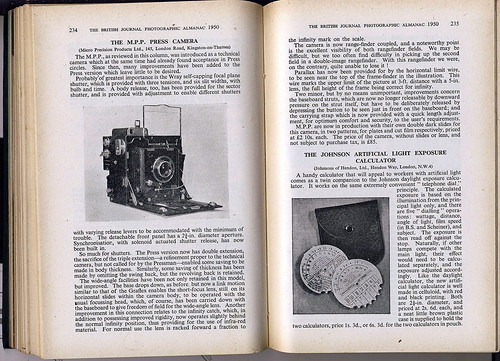
|
| review in The British Journal Photographic Almanac 1950 scanned by John-Henry Collinson (Image rights) |
The Micro-Press Camera was a press camera available through the 1950s priced £85 (1951 & 54), it differs substantially from the Micro Technical cameras and was based on the Graflex Speed Graphic (Pacemaker) with its top mounted range-finder pre-dating the Graflex top mounted range-finder by at least 4 years.
The prototype Micro-Press was reviewed in the British Journal of Photography, and reprinted in The British Journal Photographic Almanac of 1950 along with the photograph below. The prototypes were based on the Micro-Technical.
front standard and trackbed and shutter release.
Images by Ian Grant (Image rights)
MPP is the only postwar British manufacturer of TLRs. The Microcord (1951) was based on the Rolleicord; in 1954 it was followed by the Microcord Mk II,[8] with an improved shutter (the German Prontor). The Ross lens is of high quality. In 1958, MPP brought out the lever-wound Microflex, inspired by the Rolleiflex. This had excellent optics (by Taylor, Taylor & Hobson) and the camera was well made, but the crank invited hard use for which it was not designed. Shortly after its introduction, Britain dropped the high duty rates that had made Rollei equipment prohibitively expensive, and the Microflex had to be heavily discounted.
MPP had some kind of agreement with Iloca (West Germany), as a result of which MPP produced and marketed in Britain a number of cameras identical to the Iloca Rapid 1L, a leaf-shutter 35mm camera. They are marked on the top with the names of both companies.
Other products included monorail cameras, fixed-focus prison "mug shot" cameras, enlargers (even for large format), projectors, rollfilm adaptors and a flashgun that was later used for Darth Vader's lightsaber in "Star Wars".
Notes
Further reading
| British companies | ||
| Adams & Co. | Agilux | Aldis | APeM | Aptus | Artima | Barnet Ensign | Beard | Beck | Benetfink | Billcliff | Boots | British Ferrotype | Butcher | Chapman | Cooke | Corfield | Coronet | Dallmeyer | Dekko | De Vere | Dixons | Dollond | Elliott | Gandolfi | Gnome | Griffiths | G. Hare | Houghtons | Houghton-Butcher | Hunter | Ilford | Jackson | Johnson | Kentmere | Kershaw-Soho | Kodak Ltd. | Lancaster | Lejeune and Perken | Lizars | London & Paris Optic & Clock Company | Marion | Marlow | Meagher | MPP | Neville | Newman & Guardia | Pearson and Denham | Perken, Son and Company | Perken, Son & Rayment | Photopia | Purma | Reid & Sigrist | Reynolds and Branson | Ross | Ross Ensign | Sanderson | Sands & Hunter | Shackman | Shew | Soho | Standard Cameras Ltd | Taylor-Hobson | Thornton-Pickard | Underwood | United | Watkins | Watson | Wynne's Infallible | Wray |
- Skinner, Basil. Micro Precision Products: The MPP story and the products. Newquay, Cornwall: MPP Publications, 2004. ISBN 0-9546070-1-5 (See this page about it, previously at mpritchard.com.)
- Wakefield, George L. Camera movements. London: Fountain Press, 1955. The book first describes the movements possible with an MPP Micro Technical Camera Mark VI, and then discusses the use of those movements with this camera.
Sources
- "Micro Precision Products" (21 February 2006 version of Wikipedia article).
- MPP Sales literature 1959 (inc price list) JSP.3666A.59 Produced by James Sutherland Publicity Ltd.
External links
- The MPP Users' Club
- "Micro Precision Products" (current version of the Wikipedia article).
- M.P.P. MK VIII Micro-Technical PDF manual (English / French) at OrphanCameras.com
- M.P.P. Microcord MK II (2 1/4 TLR) at OrphanCameras.com
- M.P.P. MK VI 5x4 Micro-Technical PDF manual at OrphanCameras.com
